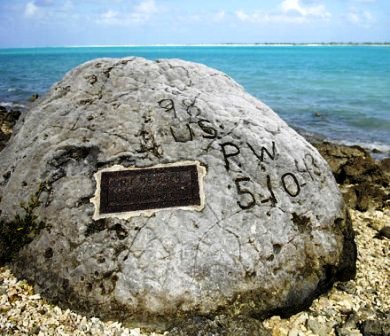The 98 Rock
Details:
Along the shore of the lagoon. Marker On December 23, 1941, the Japanese captured Wake Island and 1,603 men. Among those were 1,150 civilian contractors employed by the Morrison-Knudsen Company, part of a cooperative of eight construction companies called the Contractors Pacific Naval Air Bases, and contracted to build an airfield, seaplane base, and submarine base and to dredge a channel into the lagoon to allow access for submarines.
The U.S. Marines, sailors, and contractors were marched to the runway and seated in rows facing a line of Japanese machine guns. The men were certain that they were to be murdered. Indeed, this was the plan of the Japanese Special Naval Landing Force troops who held them. Only the intervention of Rear Admiral Sadamichi Kajioka, who commanded the invasion force, prevented the slaughter. After Kajioka arrived, an interpreter read a proclamation to the prisoners that said, in part, "The Emperor has gracefully presented you with your lives." An unknown voice bellowed from the crowd of Americans, "Well thank the son-of-a-bitch."
Three weeks after the fall of Wake, a transport ship came to take all but 360 contractors to camps in Japan and China. The remaining POWs were put to work. The Japanese did not observe the Geneva Convention restriction on using POW labor for war-related projects, and the workers toiled at various military projects.On the last day of September in 1942, all but 98 of the prisoners were loaded aboard a freighter and sent to Yokohama. The remaining POWs were to continue their work on construction projects.
The Headquarters Company commander, Lieutenant Commander Tachibana, was ordered by Admiral Sakaibara to move the prisoners from their compound to an antitank ditch on the northern tip of Wake Island. There, in the waning afternoon light of October 7, 1943, Lieutenant Torahi Ito of Headquarters Company, had the Americans lined up and seated along the ditch facing the sea. They were blindfolded with their hands and feet bound. Three platoons of Tachibana's company mowed them down with gun and rifle fire. The Americans then were dumped unceremoniously into the ditch and covered with coral sand. The following day, a report from an enlisted man that saw one of the prisoners escape during the confusion of the massacre prompted the disinterment of the bodies. The corpses were dug up and counted, then hastily reburied.
The sailor had been correct; one American was missing. That man, whose identity has not been discovered, was re-captured and was beheaded personally by Admiral Sakaibara three weeks later. During the time of his escape, near where the massacre occurred, stands a large coral rock that this American contractor had carved the date of the massacre along with "98 US PW."
Sakaibara and his subordinate, Lieutenant Commander Tachibana, were later sentenced to death for this and other war crimes. The remains of the murdered civilians were exhumed and reburied at the National Memorial Cemetery of the Pacific in section G.
Monument Text:
98 US PW 5-10-43
The plaque in the rock reads:
The 98 Rock
Commemorates:
People:
Units:
Civilian Contractor
United States Army
United States Marine Corps
United States Navy
Wars:
WWII
Battles:
Pacific Theater

